Kyrgyzstan # 5 – Tash Rabat – August 2014
As we picked up the highway coming out of the valley below Song-Köl lake, we figured we’d better top up our fuel before we hit the Chinese border. The last possible place was the town of At-Bashy. We weren’t the only ones with same idea. Trucks, buses, cars and people with jerry cans were all waiting in line. Half an hour later, we finally made it to the pump and nudged ourselves in front of a line of well used cans, interestingly enough, mostly NATO style, the same as we have used for many years. The imported European pumps measured fuel in liters and cost-per-liter in Euros. The actual price was converted to Kyrgyz Soms. After we filled our two tanks and our two reserve jerry cans, much to the annoyance of the waiting line, it worked out to 219 liters or 58 gallons at a cost of $ 3.05 per gallon. It was a seller’s market to be sure. We took a quick spin through town. There were some interesting monuments, with horses of course. After picking up a few last-minute supplies in a small corner store, we were back on the highway, which was excellent or under construction as usual.
Tash Rabat
The turn-off for Tash Rabat was good gravel as it climbed to just over 11,500 feet into a high mountain valley, and there it was, one of the most impressive caravanserais we would see on the entire Silk Road. Surrounded by mountains, this 15th century stone fortress is truly a lasting monument to the famous trading route we had been following for over a year. Originally built as a Nestorian monastery in the 10th century, the interior included 31 rooms and chambers in the main hall where merchandise could be safely stored. There were long benches, probably for sleeping. The rooms were dome-shaped, making an interesting transition from a quadrangular frame. The entire building was made of stone with a clay mortar and gypsum mortar to seal the joints. Being a popular tourist attraction, there was even a pit toilet outside, but not one you might really want to use. Before there were physical borders, border guards, customs, immigration and visas, caravans of camels and horses laden with goods from both east and west would stop here to rest and trade their treasures.
We drove out past the tourist home-stay yurts and found a perfect spot near a clear running creek. A Kyrgyz family was preparing a serious picnic near us with a small wood-burning stove and two more big pots steaming away. A few buckets of water from the creek made The Turtle V presentable for the border crossing and we enjoyed a long hot shower.
Before leaving Tash Rabat we decided to check out the nearby Sabyrbek’s Yurt Camp where we met the friendly owner, Tursun, who spoke excellent English.

For several of our sponsors, we took some PR photos of The Turtle V “yurt” parked among other yurts. Gates received this hilarious version, courtesy of an internet transmission fluke!
She runs the camp and her husband organizes horseback tours throughout Kyrgyzstan. Tursun invited us for tea and we exchanged much information about Kyrgyzstan and the puzzling behavior of tourists. Heading south, first on a good highway, then more construction and finally the road just turned rough gravel. We said goodbye to the snow-clad mountains and herds of yaks, sheep, goats and horses peacefully grazing around tidy yurts. Chinese guard towers welcomed us.
At a small blue trailer perched on rickety stilts they checked our passports and we paid the $50.00 (US) exit fee. A guard opened the gate to let us out of Kyrgyzstan into no-man’s land. Somewhere near the top of Turugart Pass, 3,752 meters, (12,909 feet), we arrived at the first entry into China where we were supposed to meet a guide who would take us to the first immigration station. Our official guide who would travel with us across the country was waiting for us in Kashgar. The first guide was not there yet, and the crossing was closed for a long lunch break. We waited. It would not be the first time. This was China.
- Always in the background were the glacier-clad mountains.
- Monuments in At-Bashy and along the road reminded us of the importance of horses in this country.
- We were not the only ones who decided fill up before heading into China or north to Osh or Bishkek. Chinese overloaded dual-trailer semis will soon destroy the new road being built.
- The classic NATO style jerry cans are still the most popular around the world.
- With only one pump, we waited for half an hour before we could take our turn.
- The imported European pumps measured fuel in liters and cost-per-liter in Euros which was irrelevant. The actual price was figured out in Kyrgyz Soms based on the number of liters.
- A little corner store was our last chance to pick up some last-minute supplies.
- Apparently no one ever read this sign.
- Only 172 kms to the Torugart Pass and the Chinese border.
- When the highways were good, they often were excellent!
- I think this sign says “Detour”.
- It was already 2014 so their Ending Date of 2013 was a little optimistic.
- The Muslim cemeteries along the road were impressive.
- The turn-off for Tash Rabat was good gravel as it climbed to just over 11,500 feet into a high mountain valley.
- Tash Rabat was one of the most impressive caravanserais we would see on the entire Silk Road.
- The Turtle V is dwarfed by the immenseness of Tash Rabat.
- There was even a pit toilet outside, but not one you might really want to use.
- A Kyrgyz family near where we camped was preparing a major picnic.
- Unfortunately Kyrgyz and others leave their trash and mess behind.
- Marmots had extensive underground colonies.
- Monika picked up some of the garbage left behind but the local cows found it interesting to investigate.
- Always a flower somewhere, this Edelweiss was waiting for Monika.
- On our way out of Tash Rabat we stopped to see what this pretty yurt home-stay camp Sabyrbek was all about.
- The owner, Tursun, invited us for tea and Monika gave her some fun children games for her young daughter.
- Tursun’s little home was simple but warm and cozy.
- Over tea, we were able to ask many questions we still had about Kyrgyzstan and Tursun wanted to learn more about foreign tourists and their often puzzling behaviors.
- The interior of these home-stay yurts were beautifully decorated and looked very comfortable.
- This guest yurt at Sabyrbek’s Yurt Camp in Tash Rabat sleeps three.
- This was the communal yurt at Sabrybek’s Yurt Camp in Tash Rabat where guests gather and eat their meals.
- All yurts have an opening in the center to let smoke and heat out. It gets covered with an outside felt flap during inclement weather.
- The handy bags were hung very conveniently to store little items. Blankets and other souvenirs were also available.
- Each yurt has its own little stove to heat water for tea and keep the room warm.
- Cow, yak or horse dung is a common source of fuel, but closer inspection showed that these piles were more like peat, which when dried also burns well.
- We parked our yurt next to the others for comparison.
- The ropes that hold the warm felt yurts together are made from horse or yak hair.
- This was a deluxe homestay with outside wash basins for the guests.
- Tursun, our host & the owner of this home-stay “yurt hotel” called Sabrybek’s Yurt Camp, poses with her daughter.
- The black baby goat insisted he be in the photo.
- The highway to the Chinese border went from pavement to construction to dusty gravel.
- These Chinese guard towers were a sign of things to come.
- This stone eagle watched over us as we headed south.
- We said goodbye to the snow-clad mountains and herds of yaks and horses peacefully grazing around tidy yurts.
- Looking for a place to camp for the night? How about the area on the far side of the yurts or??
- At a small blue trailer perched on rickety stilts they checked our passports and we paid the $50.00 (US) exit fee.
- Welcome to China. We waited for two hours. One of the most maddening bureaucracies in the world was just on the other side of the gate.



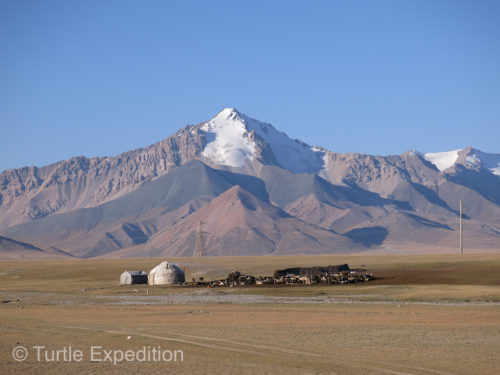


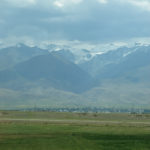
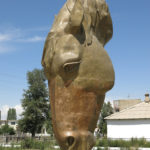

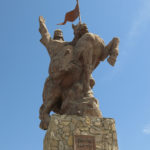

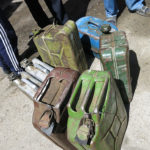

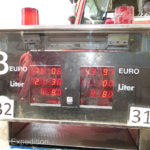
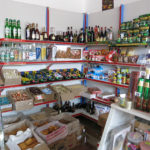
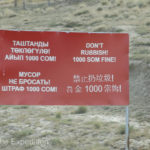
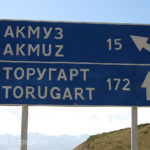

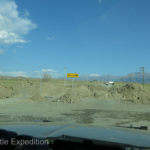


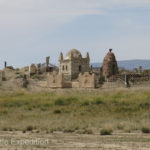

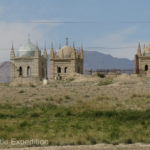


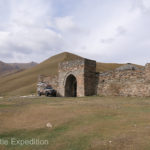
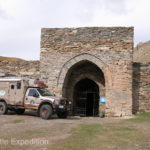
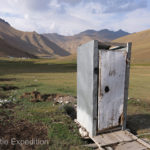



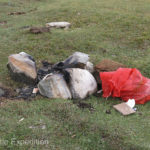
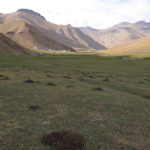

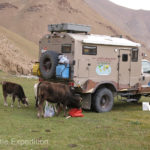
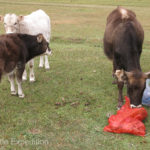


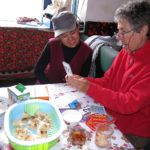
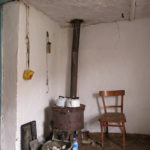

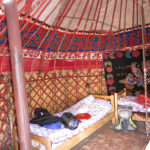
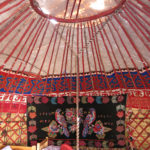

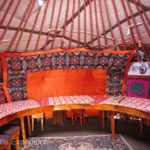


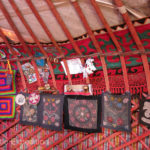




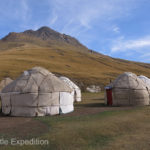

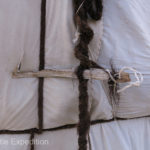
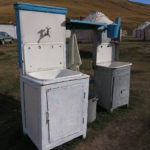
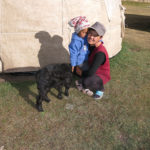
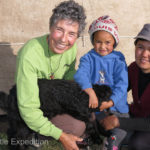
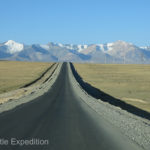






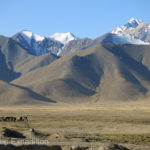

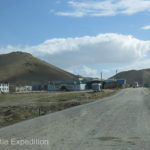

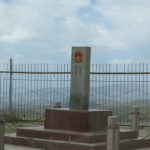





Monica and Gary. I really enjoy reading and looking at the very interesting photos of each section of your trip. It seems strange or un-usual that it was so easy for you to travel through this part of the world, with little of not trouble from the governments. I’m not sure if we are going to make it to Baja this spring as mentioned in the past. My wife is selling a house – which seems to be taking longer than anticipated. We do hope to make it to the Overland Expo in Flagstaff this May. Safe travels. Roger B
Wonderful pictures. I love the roads both the paved and the dirt. I love the roadside facility at the test stop. Very modern, it even has a door for maximum privacy. I was impressed with the spigots on the wash stands out of doors. As always though, the beautiful person you made friends with was the most impressive of all. The store seemed well stocked. I have trouble here sometimes finding Ponzu. Some of those bottles look as if they could be it. I guess California will soon, by government standards, become three states. Just think you will have more senators. A lot to think about, Ted
By the way to show I am not a robot and that I graduated from an accredited University I was tempted to put a 12 in there and then decided against it!